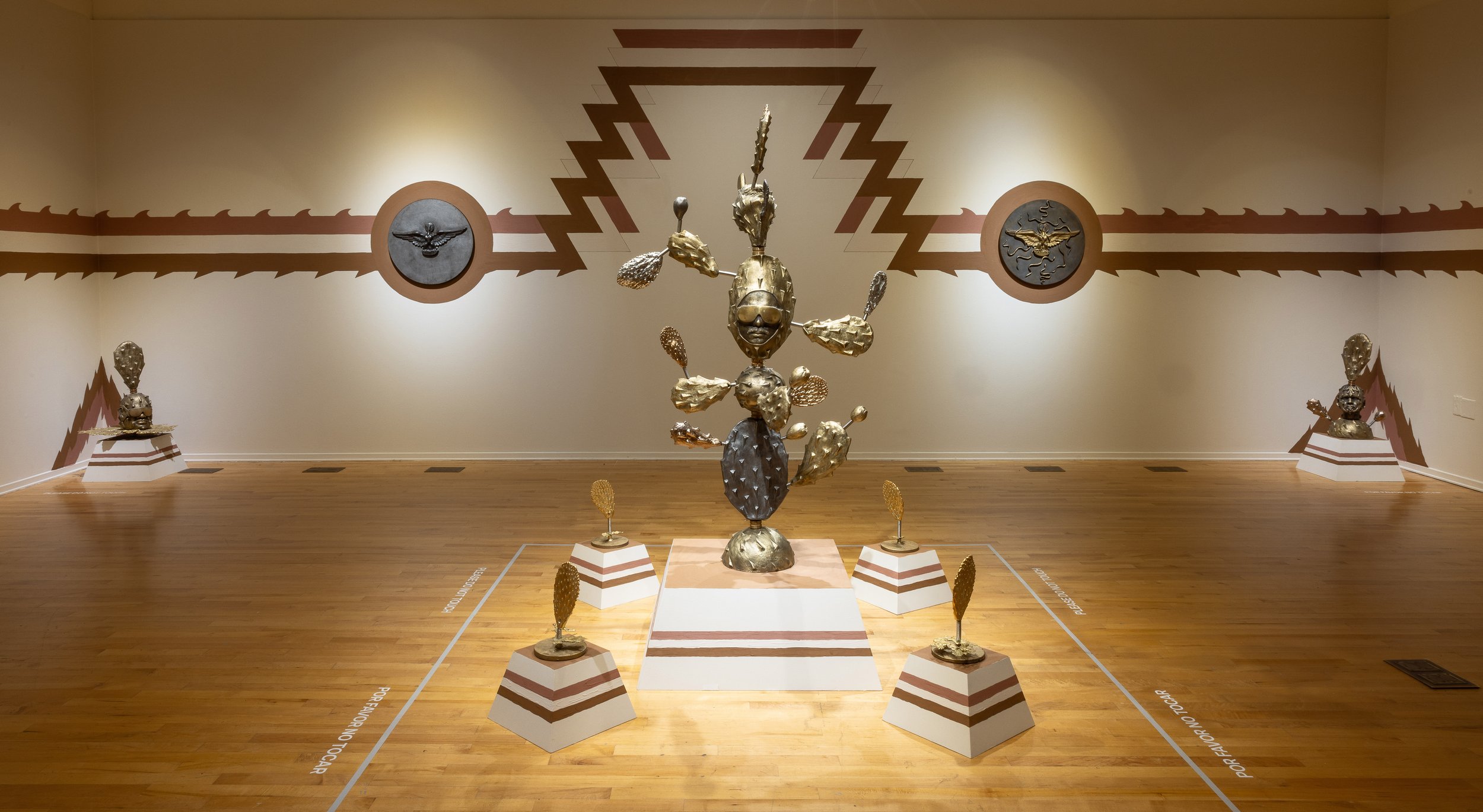NEWCITYART
BY EMMA RIVA | JANUARY 17, 2024
Salvador Jiménez-Flores, installation view of “eagle, serpiente, nopalli.” Courtesy of NMMA/Photo: Michael Tropea.
Salvador Jiménez-Flores’ “eagle, serpiente, nopalli” rolls three languages into one cohesive and thought-provoking show in Pilsen’s National Museum of Mexican Art (NMMA). The eagle portion of the title is in English, serpiente in Spanish, and nopalli in Nahuatl. The multilingual title serves as the guiding principle for the show and is one of the most incisive and effective uses of language I’ve encountered in the arts. A good title goes a long way, and Jiménez-Flores’ is no conceptual word salad but a perfect summation of the complexity within his exhibition.
The eagle “refers to the bird native to the Americas that has been appropriated as a symbol of nationalism by the United States”; the serpiente refers to “aspects of the Mexican gods Coatlicue and Quetzalcoatl recast as the symbols of biblical evil by colonizers who sought to remake the Aztec Empire into a Christian extension of Spain”; and the nopal cactus “holds its root language—Nahuatl—close as it resists translation.”
“eagle, serpiente, nopalli”‘s placement in the museum’s Xicágo Gallery—where NMMA highlights local artists—is part of what makes it so effective. A larger space might have swallowed the works, but the intimacy of the lower ceiling makes Jiménez-Flores’ sculpture and clay come even more alive. Jiménez-Flores and curator Risa Puleo centered the physical layout of the room around the metal sculpture “Space Cactus,” the artist says, and then grew the rest of the installation around it. That choice gives “Space Cactus,” which features a human-like face on a multi-limbed metal cactus, a presence that radiates throughout the room. It’s more broadly part of a ceramic installation titled “The Cosmic Life of a New World That Is Yet to Come” that sits atop an altar-like structure and has text that says “We survived” and “Our existence is our resistance” around it. Miniature cacti surround the large sculpture and flank the room’s corners.
Salvador Jiménez-Flores, installation view of “eagle, serpiente, nopalli.” Courtesy of NMMA/Photo: Michael Tropea.
It was Puleo who came up with one of the key spatial elements of “eagle, serpiente, nopalli” that makes it an engaging viewing experience, Jiménez says. Rather than using labels to delineate the artwork, Puleo intersperses parts of the curatorial statement around the room so viewers can engage with the show more as a narrative whole rather than divided up into parts. With choices like this, the show manages to walk a line of presenting symbols of hierarchy and power in a non-hierarchical manner. The eagle is an overt symbol of nationalism, the snake of power, and the nopal of survival, and all of these thematic inquiries lead back to the question of migration and its effects on personal autonomy.
Due to the relatively small amount of space in the Xicágo Gallery, the museum limits the number of visitors that could be in Jiménez-Flores’ exhibition at a time. This gives the installation work a sense of sacredness and intimacy. I found a quiet came over me when I shut the door to enter the room, and as I do with much ceramic or metalwork, I felt a closeness to the objects. They take up space just as we do. Jiménez-Flores wants to create an environment that people can feel a part of. Handprints painted in an earthy red above the doorway are a way for Jiménez-Flores to “leave a mark” and connect to pre-Columbian mural traditions. “eagle, serpiente, nopalli” uses the walls as part of the exhibition experience. Stripes and circles surround the hanging works. The stripes add to the closeness with the objects, a feeling that the walls are not just meant to constrain you but to expand. In a concept that draws so much from migration, it’s powerful to see walls not just as walls.
Salvador Jiménez-Flores, installation view of “eagle, serpiente, nopalli.” Courtesy of NMMA/Photo: Michael Tropea.
“eagle, serpiente, nopalli” is on view concurrently with Felipe Baeza’s Unruly Forms, a Public Art Fund-sponsored series of images of pre-Columbian objects on bus shelters across the city, including at 18th and Damen in Baeza’s home neighborhood of Pilsen. (Baeza’s installation closed in November 2023 and was a product of Public Art Fund’s partnership with JCDecaux, which manages bus shelters in multiple cities). Baeza and Jiménez-Flores attended high school together and though the timing of their projects was coincidental, both projects raise questions about migration and identity through kitsch. Both try to merge the fetishized “ancient” with a future that stretches beyond what a colonial society can imagine, using in Jiménez-Flores’ case science fiction and in Baeza’s case the fantastical or macabre.
“eagle, serpiente, nopalli” crystallizes some of the most profound questions about art as a whole and what it can do. How do objects change based on their context? How does memory change an object, and when does an object become a work of art? When does a room become a gallery, when does a gallery become a museum? Museum shows themselves have a kind of migratory property to them—the artwork arrives at the museum space, is on view for a moment, then is de-installed and leaves, often hastily. “eagle, serpiente, nopalli” is not just any of the single pieces within it, but the whole room, the walls, the lights, Puleo’s writing. It’s an example of how a museum setting with a thoughtful curatorial strategy uses all of the space and resources available. A guiding principle for Jiménez-Flores is “resourcefulness,” and that comes through not just in the content of the show but in its execution. With its presence in the central sculpture and placement across the space, the nopal is arguably the most prominent part of “eagle, serpiente, nopalli”—fitting that the element that resists translation is the one that comes through the most strongly.
“eagle, serpiente, nopalli” is on view at the National Museum of Mexican Art, 852 West 19th, through February 4.


